Córdoba, Thursday-Sunday, June 28-31, 2007
Between the Guadalquivir River and the Sierra Morena mountains
The city of Córdoba is bounded on the south by the Guadalquivir river and on the north by the Sierra Morena mountains. We were not able to get a good photograph of this, but the Wikipedia does have one. (Beware the possibility of link rot; the following photo may disappear. The Wikipedia article about the Guadalquivir has a larger version of the photo. Click this one to see it.)

Though contemporary shipping cannot get much inland beyond Seville, during the ancient period and probably, at least, up through the time when Córdoba was the capital of the Umayyad Caliphate of Córdoba (from 929 to 1031) the Guadalquivir served as a shipping point for the agricultural and mining produce of the area. Jews of this period played a role in the cultural life of the city.
Arrival at campsite
We arrived in the city early enough in the afternoon to drive around and find a parking place near the central square. However, at siesta the Tourist Information kiosk was closed. We found a coffee shop on Plaza de las Tendillas where Debbie sat out the heat for a while and Mark found a good bookstore where he purchased a Michelin map of the city. This is the only time we’ve bought a local city map. The proprietor of the bookstore even showed him where the municipal! campsite was. We found it and easily settled in.
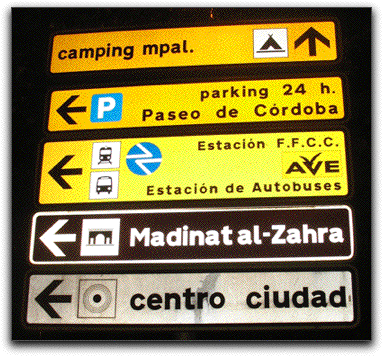
Hot time in the old town tonight
We began our exploration of Córdoba on Friday morning, walking down into the old town which, once again (as in Barcelona and many other places) corresponds with La Judería. However, in Córdoba, nearly the entire “Old City” is called La Judería. Going into the old town usually means a downhill walk towards the river… and, since water usually flows downhill…. From our reading we knew that there was a plaza named for Judah ha Levi and a statue of Maimonides, both of which we wanted to see. As we walked along what appeared to be the appropriate narrow street

we saw the signs (as in Amusco and elsewhere) implying “we are rid of the Jews, but they do make for good marketing.”

We looked for the Plaza of Judah ha Levi and walked past the old ice-cream parlor and bar where he recited poetry…
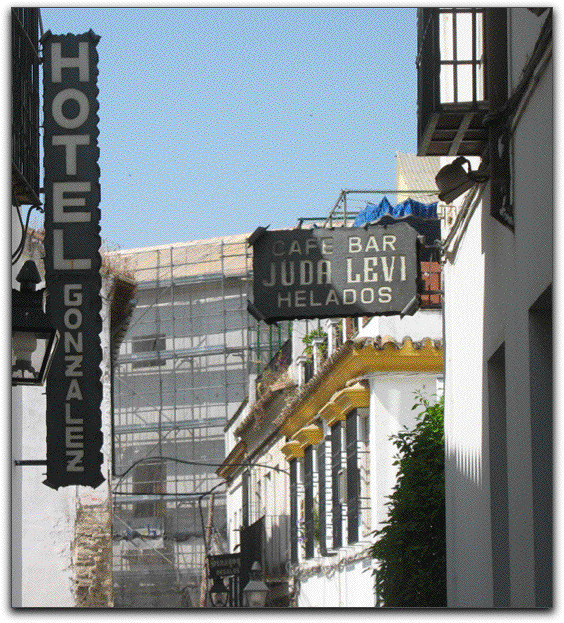
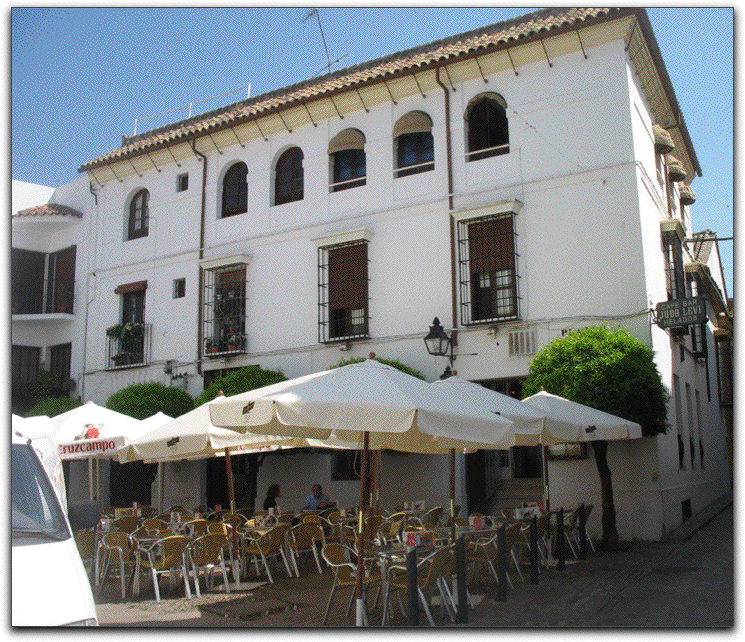
…well, maybe he only slept there. But, we couldn’t find the plaza. We continued following our map and walked nearly out of town to the river. Doubling back a bit we unexpectedly ended up at an old Roman (?) wall, with a pedestrian park (unmarked on any of our maps) and a little walkway named for the first Jew to assume a significant responsibility in Córdoba, as a physician, diplomat, and patron of science: Hasdai ibn Shaprut.
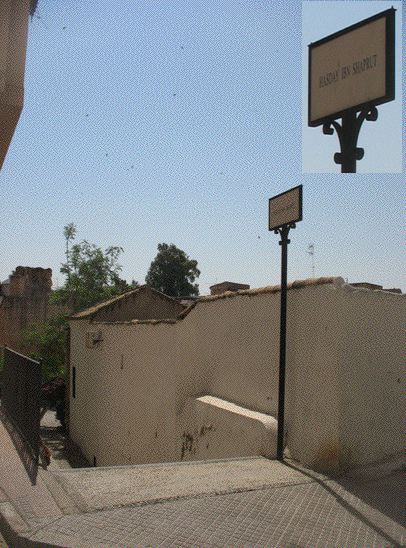
We found our way back into the city via the Puerto de Almodóvar, which in an earlier period had been called Bal al Yahud “Gate of the Jews.” There are a number of “Almodóvars,” and we were unable to find out the core meaning of the word. This gate seems to have led out west a few kilometers to Almodóvar del Rio, a beautiful castle on the river (which we did not visit). Hugging the inside of the old city wall, not to be confused with “Calle de la Judería,” with which it does not intersect: “Calle de los Judíos.”
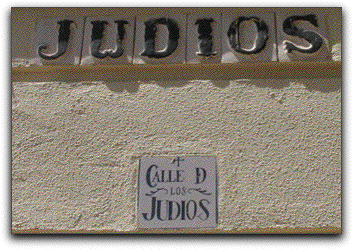
From Moses to Moses, there is none like Moses
Moses Maimonides (RaMBaM = Rabbi Moses Ben [son of] Maimon) was born in the year 1135, supposedly in what is now known as building #5 on this narrow street (Calle de los Judíos).

The great Muslim Aristotelian philosopher and physician Ibn Rushd (also known as Averroes) had been born in Córdoba nine years earlier. Maimonides and Ibn Rushd grew up in Córdoba. Maimonides left in 1148 at the age of 13, via Cádiz. He probably sailed down the Guadalquivir. Ibn Rushd left two years earlier. Mark could imagine that these two brilliant youngsters encountered each other, but, it is unlikely. At the time, Córdoba, as the largest city in western Europe and possibly the world, may have had more inhabitants than it currently has!
Nonetheless, much literature about one of these geniuses, mentions the other and suggests that Rambam was influenced by Ibn Rushd. And, the great author of steam of consciousness, James Joyce, places them in the same sentence twice in his masterpiece Ulysses. The following texts are thanks to Project Gutenberg (early in the novel):
Across the page the symbols moved in grave morrice, in the mummery of their letters, wearing quaint caps of squares and cubes. Give hands, traverse, bow to partner: so: imps of fancy of the Moors. Gone too from the world, Averroes and Moses Maimonides, dark men in mien and movement, flashing in their mocking mirrors the obscure soul of the world, a darkness shining in brightness which brightness could not comprehend.
…and then, somewhere in the middle (highly edited from a very long paragraph):
Thereat laughed they all right jocundly only young Stephen and sir Leopold which never durst laugh too open by reason of a strange humour which he would not bewray and also for that he rued for her that bare whoso she might be or wheresoever. Then spake young Stephen orgulous of mother Church that would cast him out of her bosom, of law of canons, of Lilith, patron of abortions, of bigness wrought by wind of seeds of brightness or by potency of vampires mouth to mouth or, as Virgilius saith, by the influence of the occident or by the reek of moonflower or an she lie with a woman which her man has but lain with, EFFECTU SECUTO, or peradventure in her bath according to the opinions of Averroes and Moses Maimonides.
One Free Association Deserves Another
after all, it’s free
Joyce also mentions Maimonides in a different context near the end of his novel, for which there exist some variants:
Accepting the analogy implied in his guest's parable which examples of postexilic eminence did he adduce?
Three seekers of the pure truth, Moses of Egypt, Moses Maimonides, author of MORE NEBUKIM (Guide of the Perplexed) and Moses Mendelssohn of such eminence that from Moses (of Egypt) to Moses (Mendelssohn) there arose none like Moses (Maimonides).
Some sources use the phrase “From Moses to Moses” and refer only to “Moshe Rabeinu” and “Rambam.” This text supposedly decorates Rambam’s tomb, in Tiberias, Israel. An odd item suggests that the third Moses is not Joyce’s “Mendelssohn,” but actually the adapter of the Shulchan Aruch for the Central European Jewish (Ashkenazi) populace: Moses Isserles.
Down the block from the birthplace is a plaque portraying the symbol of the Israeli city of Tiberias.
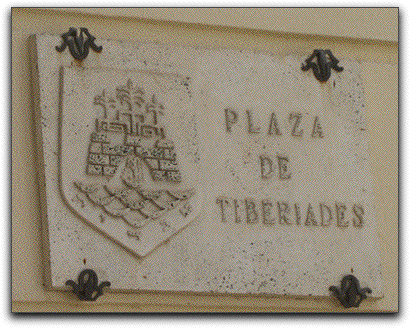
Also in the little plaza hangs a plaque commemorating the 800th anniversary of Rambam’s birth, placed before the elections that led to the Civil War.

And, there, thoughtfully ‘watching’ the passers-by:
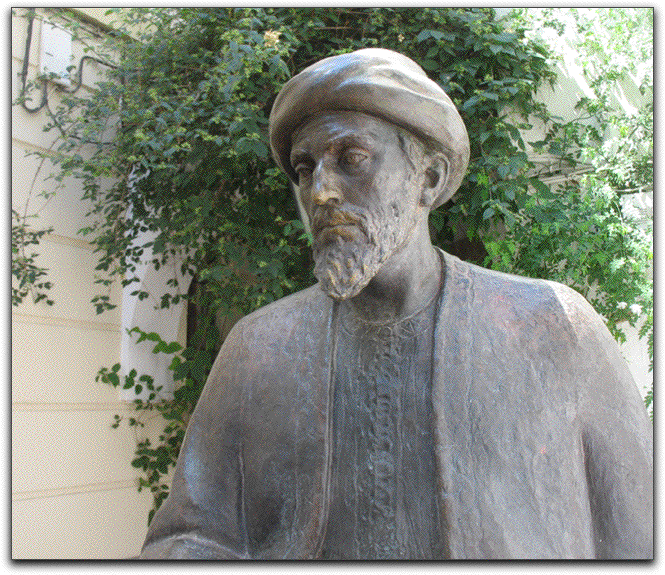
In the ’hood
Between #5 and the plaza, the street curves ever so gently. Placed strategically a, seemingly healthy young woman begs with her toddler in her lap

near the entrance to one of Córdoba’s prized possessions: a synagogue that predates the Expulsion.
Six Degrees & Eight Degrees
It is hard to imagine that there might be only six degrees of separation between us and this woman begging with her child in her lap. The “Eight Degrees” deals with how we should respond to her. Among Maimonides’ many writings is an analysis of various modes of giving “charity” for which the Hebrew word צדקה (TZeDaKaH = justice) offers a different approach. צדקה suggests the requirement of creating a just society, as contrasted with “caritas” acts emerging out of feelings of unlimited loving-kindness (in Hebrew חסד ḤeSeD). What are the immediate options for responding to a beggar in the street? We cannot restructure Córdoban society so that she has a job. Even if it is the lowest level of giving, we should have, even grudgingly, dropped a few coins in her hand, except ever since he was in his early teens, when he first saw a student performance of The Threepenny Opera at USC, Mark has been leery of the honesty of beggars. All of this talk about tzedaka here only proves that the woman still holds our attention.
We stepped into the synagogue of 1315,
Sacred Destinations Travel Guide Web site calls this:
the only synagogue in Andalusia to survive the Expulsion and Inquisition of the Jews in 1492.
While the building itself, unlike so many others, was not destroyed it became a mosque and a church and a hospital before being turned into the current tourist attraction. A more detailed story is told by the Sephardic Council. The room is small, though with a very high ceiling, and dim. We enjoyed the Mudejar style of geometric combination of 8x6x4 patterns in Granada and would continue to enjoy it numerous times throughout our peregrinations.
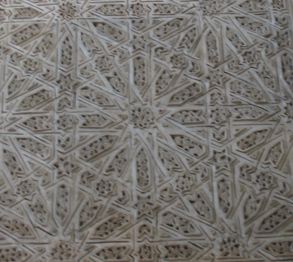
As though to confirm that the building is now a museum representing a destroyed synagogue, someone has placed a little menorah in a niche of the east wall.
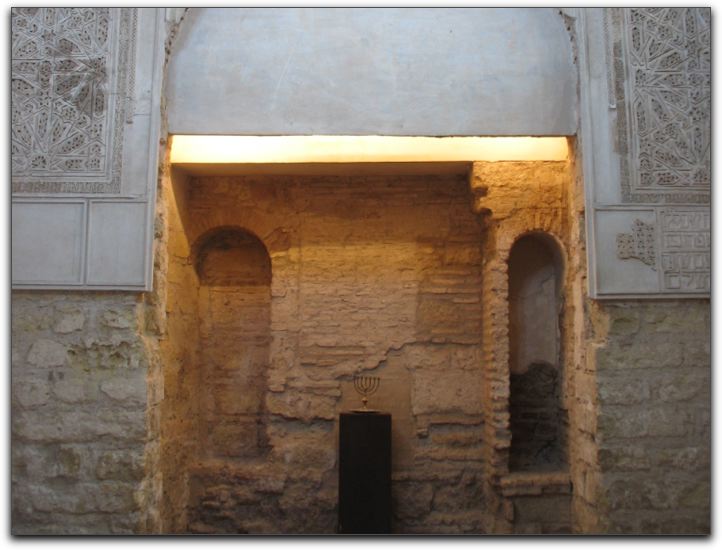
While we were there a group Christians visited to see what had been the church. Before the Christians arrived about thirty young American USY Jews on a tour of Spain and Israel, most from the Midwest, but a few from California, entered the little synagogue. They got a quick lesson on the history of the Jews in Córdoba and were sent off to explore the city for a short time on their own before their bus took them to Toledo for Shabbat.
Jews on Postage Stamps
One of the local streets houses a serious philatelic shop. With the increasing use of email, postage stamps are becoming even more unusual items to collect. Mark’s father collected postage stamps for many years and the family has his notebooks. The shops sells some of the stamps also in the Hurvitz collection, among them Spanish stamps depicting Maimonides and Christopher Columbus. Some sources suggest that Queen Isabella gave Christopher Columbus his commission while she and Ferdinand resided in Córdoba. However these two stamps are not in the Hurvitz collection.

Why would a postage stamp of Christopher Columbus be in a collection of Jews on postage stamps? Among the many theories of Columbus’ origins, one suggests that he was a converso (a recent convert to Christianity) who still had ties with the Jewish community. On the Web you can find a number of articles dealing with the subject. One is an interesting article (needing copy editing) that frames the discussion in relation to Queen Esther and the story of Purim. Another is from the infamous site “Jew Watch” to which I will not add a link (but the extension is: [/jew-leaders-columbus.html]. An interesting question:
- Is “Jew Watch” pleased or not that Columbus might have been a Jew?
Most of the other shops on the street sell “traditional” tourist goods. However, a certain syncretism, or growing acceptance of differences (as in the words of one Web site),
Capital of the western world in the 11th century, Cordoba is not only a convenient stop in central Andalusia, but the essence of Spain in that Iberian, Roman, Visigoth, Jewish, Islamic and Christian civilizations, are captured in its stones, its monuments and its collective consciousness.
or knowledge that a significant proportion of those who wander down this street will be Jews… and will want a Jewish souvenir of Córdoba is evident.

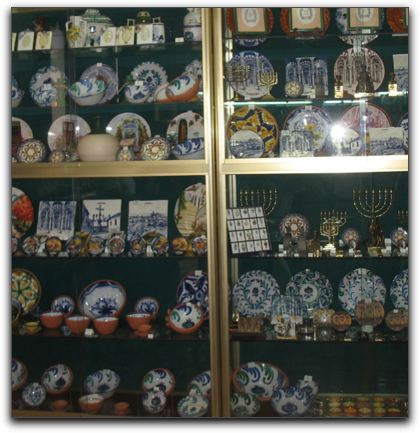
Most interesting are the T-shirts. The text on the red one reads: “The secret is the mixture”
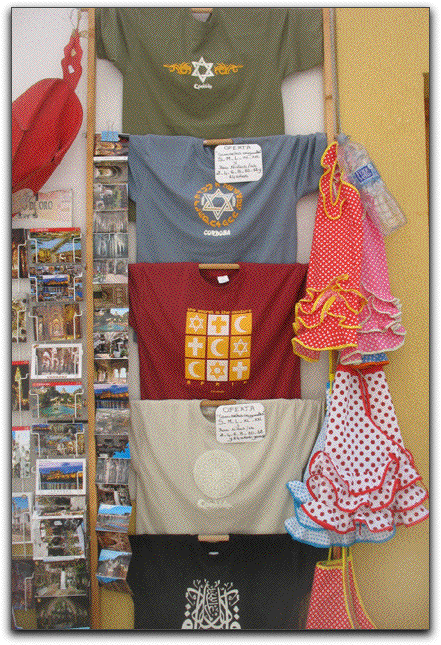
Turning a corner, we entered a little plaza we had passed from a different direction. From this angle, the signs were visible behind the trees.

We would come back here, not for ice-cream or a drink, but for a light Shabbat dinner before returning to our campsite. But, first we needed to get clean for Shabbat.
Hammam - Baños Árabes
While in Granada we saw a brochure for “Arab Baths.” The option sounded intriguing, but we did not have the time for it while there. Similar baths exist in Córdoba and Madrid so, we packed our bathing suits before we left the van in the morning. We made our appointment in the morning and returned late in the afternoon for an hour and a half of soaking along with a fifteen minute massage. After weeks of taking showers in strange places, the physical pleasure of immersing ourselves in the cold, then tepid, then hot waters… and back, and forth… with soft candle light and fragrances… even if there were another 20 people in the pools, was luxurious.
Córdovan Shabbat
The Wikipedia article on Córdoba reports that the city has “the highest maximum temperatures in Europe.” Our later experience in Seville might contradict that. However Córdoba was very hot. We spent Shabbat day reading sitting in the shade around, and swimming in the pool at the campsite. In the late afternoon when it appeared to cool off a bit we walked back into town. Glancing at the various digital clocks/thermometers we could see that the temperature was near 40c (104f)! We wanted to see the Casa de Sefarad. The well done museum’s Web site links to several Sefardic cultural institutions. The museum uses an old house in the Judería to display a collection of materials related to the Sefardic experience. We explored and then chatted with the shop attendant about the “Casa.” He appreciated our interest and, without yet knowing who we were, took us up to the closed library to show us an original document from the Inquisition. The Casa has been working to collect these documents whenever they turn up on the market. One of the exhibits portrays near-life-size recent paintings of earlier accomplished Andalucían women, among them one of “the wife of Dunas ben Labrat,” who was contemporary of Hasdai ibn Shaprut and had written one of the now popular Shabbat Z’mirot: “Dror Yikra”
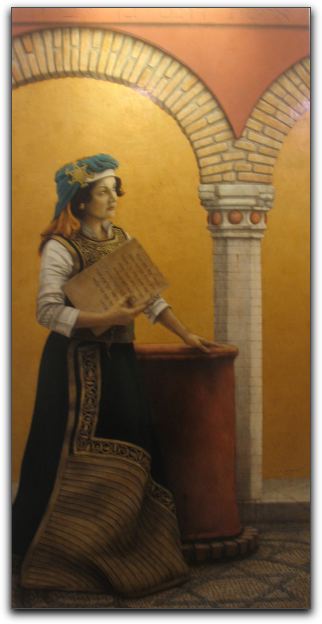
along with a poem that she had written.
Will her beloved remember the gracious deer
the day of his departure, with his only child in her arms?
He put the ring from his right hand on her left hand,
on his arm she put her bracelet;
when she took his veil as a keepsake,
he took hers so as not to forget her.
He will not stay in Sepharad
even if he were given half his master’s kingdom.
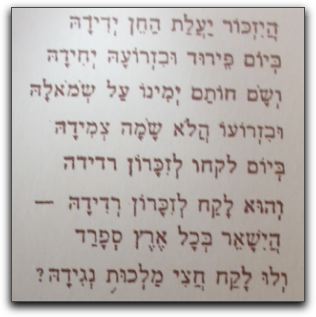
We returned to the Mezquita only to learn that we had miscalculated (or been misinformed about the closing time) once again. It was still fairly early in the evening… not near dark. So we settled into the lobby of …

At Home With Rambam…
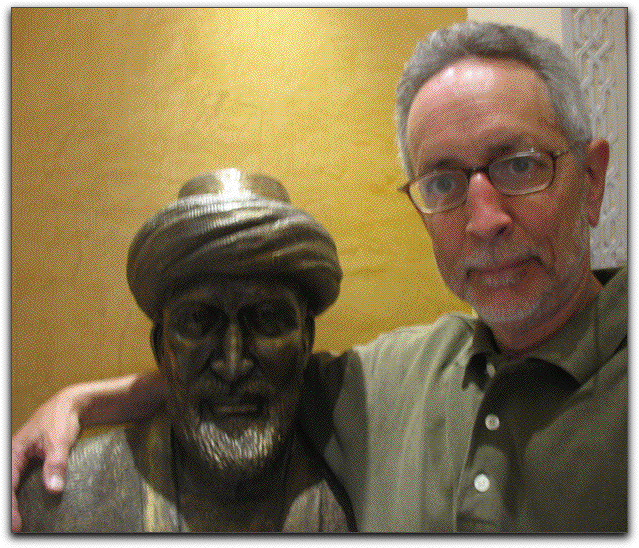
Who’d a thunk. We found some comfy sofas in the airconditioned lobby, electric outlets and resumed composing the reports of our trip. When, lo and behold we connected to free wireless… without even a password.
The upscale Hotel Maimonides’ tschotchkes attracts various cultural groups.
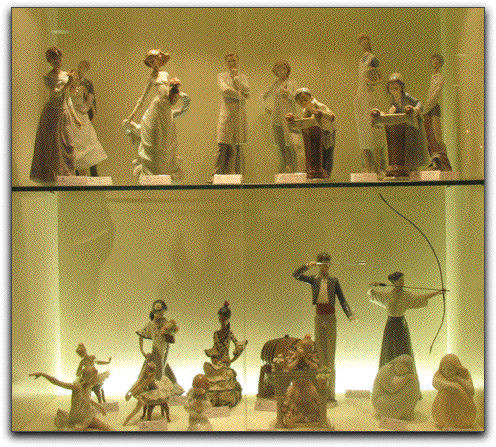
The hotel is directly across the street from the Mizquita, another odd juxtaposition (and we’ve seen many). That’s the Mizquita on the right through the front door.

Mark asked the staff
- ¿Why is the hotel named after Maimonides?
- Maimonides was from Córdoba.
- ¿Why him rather than someone else?
- Averroes was already taken!
Long after dark we found a place to get a simple meal and later a cup of iced coffee back at the Plaza de las Tendillas before walking home. The temperature had dropped to only 30c (86f) by 23:30.
To Church on Sunday
We checked out of the campsite and drove around to the south bank of the Guadalquivir to park the van in a free area with shade. Walking along the river to the bridge we could hear the bells of the old Mosque (Mezquita in Spanish)… now Cathedral pealing, birds flying around the steeple.
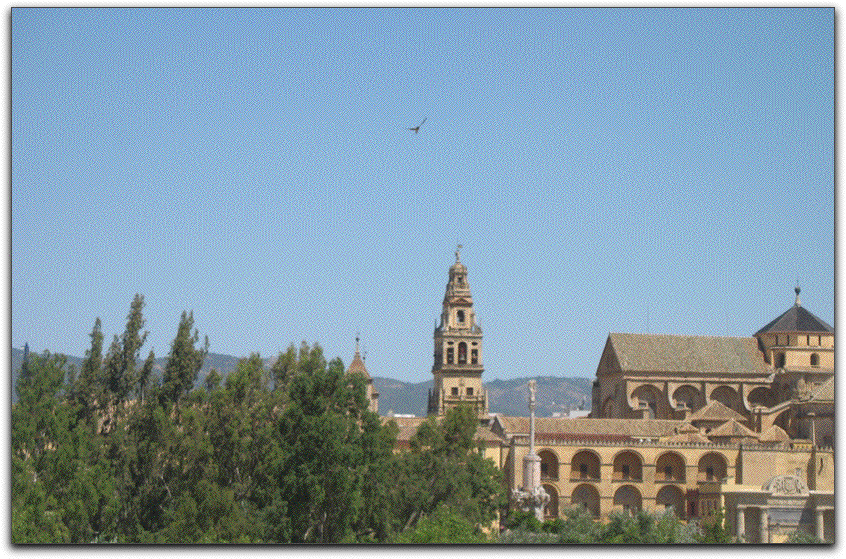
Since the old Roman bridge was under renovation,

we continued on to a new bridge to get to the Mezquita.

Finally inside the Mezquita, it took a while for our eyes to adjust. Most photographs you see must have been taken with flash. However, the signs all around tell the casual visitor not to use flash.

In some spots, the sunlight pours in. There are supposedly a thousand columns. The double arches are a solution to the problem of holding up a particularly high and heavy ceiling.
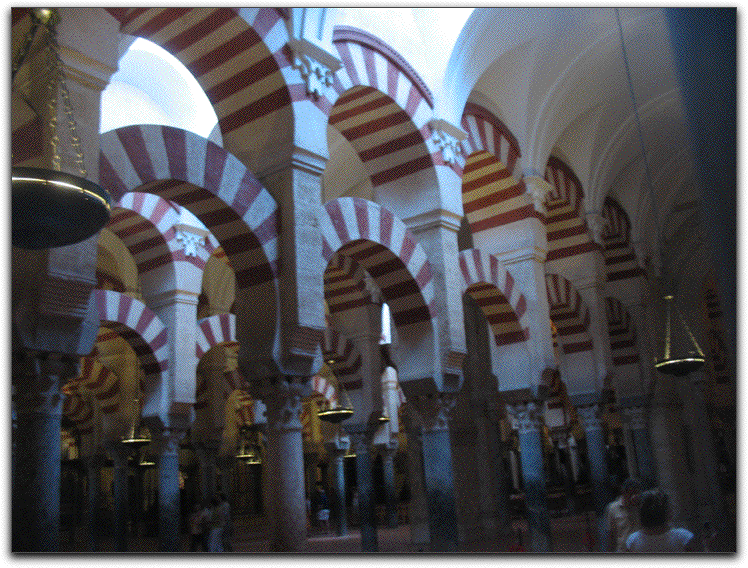
We walked back and forth, following the Church’s official guide pamphlet we received on entering and the notes from the Michelin guidebook our friends in San Diego had lent us. The politics of the site are evident in the literature.
From the Cathedral pamphlet :
Beneath every cathedral is always a bed of hidden cathedrals. In the case of Córdoba, tradition traces back to its Visigoth origins. This fact is confirmed by archeological excavations, whose remains can be found at the Museum of San Vicente (Saint Vincent) and in the pits where the remains of the ancient Christian temple can be observed on site.
These?
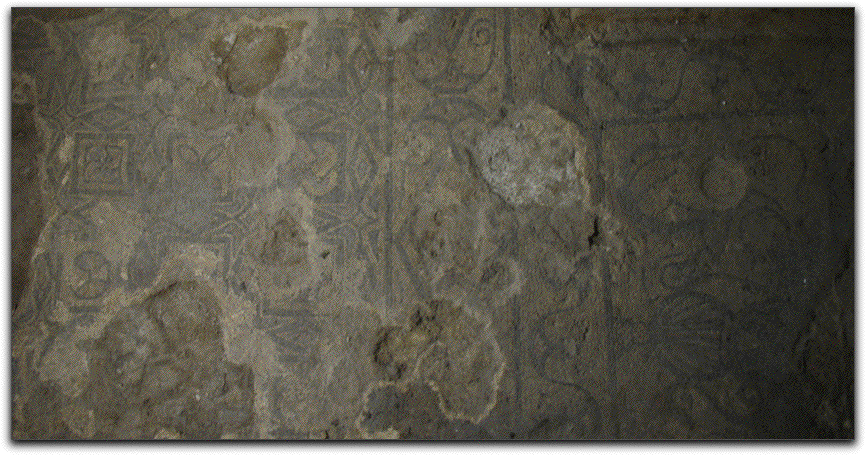
The pamphlet continues
It is a historical fact that the basilica of San Vicente was expropriated and destroyed in order to build what would later be the Mosque, a reality that questions the theme of tolerance that was supposedly cultivated in the Córdoba of the moment. [italics added by Mark] This was the main church of the city, a martyry basilica from the 6th century, that would be remembered and venerated by Christians, centuries after its destruction.
Similarly from a different page of the pamphlet:
It is the Church, through its Cathedral Chapter, that has made it possible to keep the former mosque of the Western Caliphate, the oldest cathedral in Spain, and a World Heritage Site, from becoming a heap of ruins. [italics added by Mark… as if, had it remained a mosque it might not have been maintained?] In fact this has always been one of the missions of the Church; to safeguard and inspire culture and art.
The visit to the Cathedral of Córdoba may awaken the demand for a greater Beauty that will not wither with time. Because beauty, as truth and righteousness, are an antidote for pessimism, and an invitation to take pleasure in life, an impact that stirs the nostalgia of God.
Not everyone in the Christian world was pleased with the transformation of the Mosque into a Cathedral. According to Michner:
However, when Carlos ascended the throne, the Christian hierarchy of Córdoba saw a chance to do something they had long wanted to do but which Fernando and Isabel, sensitive to the Moorish architecture of the south, would never haver permitted. They wan ted to erect across the inconspicuous nave a transept, which wen properly covered and cut off from the rest of the mosque, would constitute a proper cathedral. they therefore petitioned Carlos for permission to do this, and he, knowing nothing of the problem for he did not appreciate the south, carelessly granted it. Speedily Christian stonemasons went to work and built, right in the heart of the mosque, their monstrous structure. When Carlos finally visited Córdoba in 1526 and saw what had been done under his aegis he was ashamed, saying, “If I had known what you were up to, you would not have done it. For what you have made here may be found in many other places, but what you have destroyed is to be found nowhere else in the world.”
Mark has learned how to use the timer to take photos in dim light… otherwise pressing the shutter button causes the camera to move. He also prefers an-iconic art to iconic art
iconic

an-iconic

Back across the Guadalquivir
As stated at the beginning, Córdoba’s greatness seems to have begun with the use of the river as an economic thoroughfare. Sadly, the Guadalquivir also marks the end of Córdoba’s greatness. A plaque along the south bank of the river reads:
For many years, the river has shown its dark side to the city with periodic flooding and pollution. It was even the place chosen by the Spanish Inquisition for burning condemned prisoners!

We hope that the new bridge we had crossed earlier in the day, and the restored Roman bridge over the river symbolize a return to open communication and interchange that made Córdoba great.
We returned to our van, ate a light lunch, and headed south to Málaga once again on the Mediterranean coast, by way of Lucena.
start || back || next




































